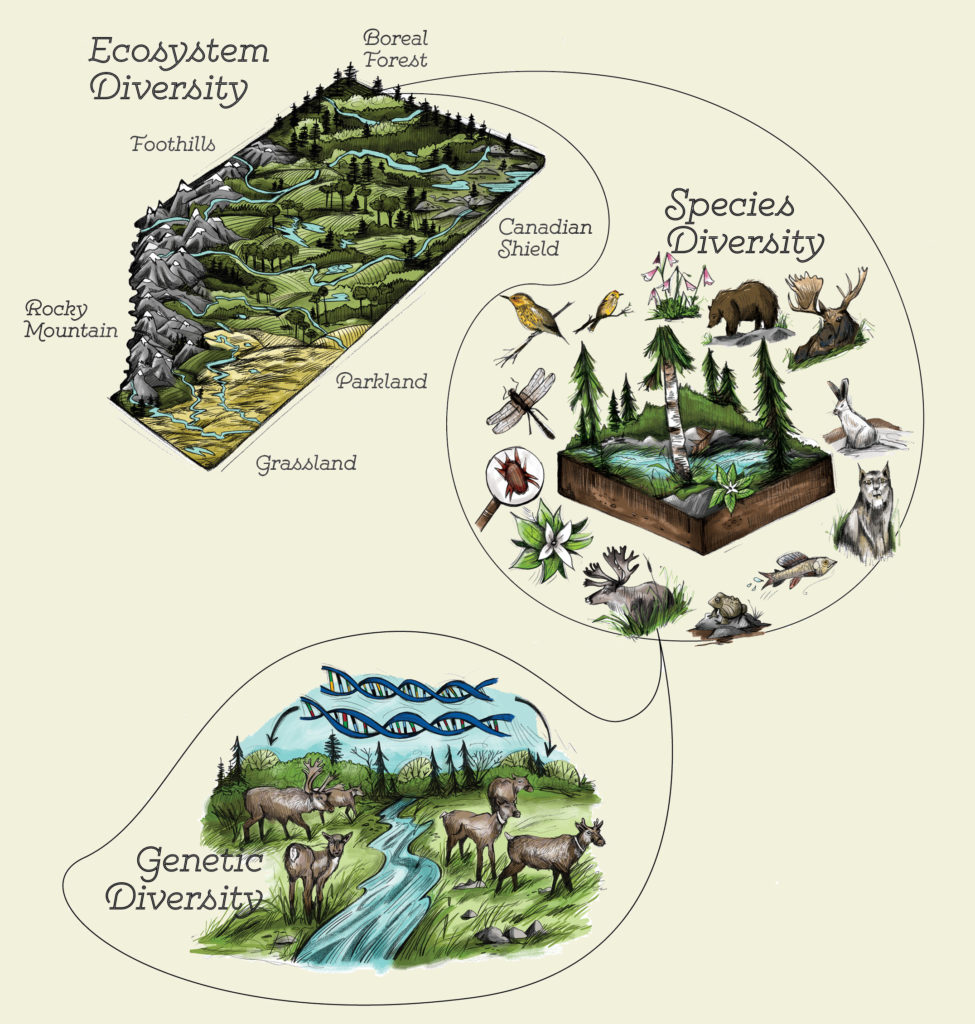Learning Outcomes
- Explain the “diversity of life”

Figure 1. Life on earth is incredibly diverse.
Biological diversity is the variety of life on earth. This includes all the different plants, animals, and microorganisms; the genes they contain; and the ecosystems they form on land and in water. Biological diversity is constantly changing. It is increased by new genetic variation and reduced by extinction and habitat degradation.
What Is Biodiversity?
Biodiversity refers to the variety of life and its processes, including the variety of living organisms, the genetic differences among them, and the communities and ecosystems in which they occur. Scientists have identified about 1.9 million species alive today. They are divided into the six kingdoms of life shown in Figure 2. Scientists are still discovering new species. Thus, they do not know for sure how many species really exist today. Most estimates range from 5 to 30 million species.
Cogs and Wheels
To save every cog and wheel is the first precaution of intelligent tinkering.
—Aldo Leopold, Round River: from the Journals of Aldo Leopold, 1953
Leopold—often considered the father of modern ecology—would have likely found the term biodiversity an appropriate description of his “cogs and wheels,” even though the idea did not become a vital component of biology until nearly 40 years after his death in 1948.
Literally, the word biodiversity means the many different kinds (diversity) of life (bio-), or the number of species in a particular area.
 Biologists, however, are always alert to levels of organization, and have identified three unique measures of life’s variation:
Biologists, however, are always alert to levels of organization, and have identified three unique measures of life’s variation:
- The most precise and specific measure of biodiversity is genetic diversity or genetic variation within a species. This measure of diversity looks at differences among individuals within a population, or at difference across different populations of the same species.
- The level just broader is species diversity, which best fits the literal translation of biodiversity: the number of different species in a particular ecosystem or on Earth. This type of diversity simply looks at an area and reports what can be found there.
- At the broadest most encompassing level, we have ecosystem diversity. As Leopold clearly understood, the “cogs and wheels” include not only life but also the land, sea, and air that support life. In ecosystem diversity, biologists look at the many types of functional units formed by living communities interacting with their environments.
Although all three levels of diversity are important, the term biodiversity usually refers to species diversity!
Video Review
Watch this discussion about biodiversity:
You can view the transcript for “Biodiversity from ‘the Wild Classroom'” here (link opens in new window).
Biodiversity provides us with all of our food. It also provides for many medicines and industrial products, and it has great potential for developing new and improved products for the future. Perhaps most importantly, biological diversity provides and maintains a wide array of ecological “services.” These include provision of clean air and water, soil, food and shelter. The quality—and the continuation— of our life and our economy is dependent on these “services.”
Australia’s Biological Diversity

Figure 2. The short-beaked echidna is endemic to Australia. This animal—along with the platypus and three other species of echidnas—is one of the five surviving species of egg-laying mammals.
The long isolation of Australia over much of the last 50 million years and its northward movement have led to the evolution of a distinct biota. Significant features of Australia’s biological diversity include:
- A high percentage of endemic species (that is, they occur nowhere else):
- over 80% of flowering plants
- over 80% of land mammals
- 88% of reptiles
- 45% of birds
- 92% of frogs
- Wildlife groups of great richness. Australia has an exceptional diversity of lizards in the arid zone, many ground orchids, and a total invertebrate fauna estimated at 200,000 species with more than 4,000 different species of ants alone. Marsupials and monotremes collectively account for about 56% of native terrestrial mammals in Australia.
- Wildlife of major evolutionary importance. For example, Australia has 12 of the 19 known families of primitive flowering plants, two of which occur nowhere else. Some species, such as the Queensland lungfish and peripatus, have remained relatively unchanged for hundreds of millions of years.
Try It

